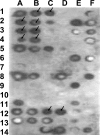Identification of ciliary neurotrophic factor receptor alpha as a mediator of neurotoxicity induced by alpha-synuclein
- PMID: 20340160
- PMCID: PMC3013276
- DOI: 10.1002/pmic.200900745
Identification of ciliary neurotrophic factor receptor alpha as a mediator of neurotoxicity induced by alpha-synuclein
Abstract
Accumulating evidence suggests that extracellular alpha-synuclein (eSNCA) plays an important role in the pathogenesis of Parkinson's disease or related synucleinopathies by inducing neurotoxicity directly or indirectly via microglial or astroglial activation. However, the mechanisms by which this occurs remain to be characterized. To explore these mechanisms, we combined three biochemical techniques - stable isotope labeling of amino acid in cell cultures (SILAC), biotin labeling of plasma membrane proteins followed by affinity purification, and analysis of unique proteins binding to SNCA peptides on membrane arrays. The SILAC proteomic analysis identified 457 proteins, of which, 245 or 172 proteins belonged to membrane or membrane associated proteins, depending on the various bioinformatics tools used for interpretation. In dopamine neuronal cells treated with eSNCA, the levels of 86 membrane proteins were increased and 35 were decreased compared with untreated cells. In peptide array analysis, 127 proteins were identified as possibly interacting with eSNCA. Of those, seven proteins were overlapped with the membrane proteins that displayed alterations in relative abundance after eSNCA treatment. One was ciliary neurotrophic factor receptor, which appeared to modulate eSNCA-mediated neurotoxicity via mechanisms related to JAK1/STAT3 signaling but independent of eSNCA endocytosis.
Figures






Similar articles
-
The acute inflammatory response to intranigral α-synuclein differs significantly from intranigral lipopolysaccharide and is exacerbated by peripheral inflammation.J Neuroinflammation. 2011 Nov 28;8:166. doi: 10.1186/1742-2094-8-166. J Neuroinflammation. 2011. PMID: 22122884 Free PMC article.
-
Rab11a and HSP90 regulate recycling of extracellular alpha-synuclein.J Neurosci. 2009 Feb 4;29(5):1480-5. doi: 10.1523/JNEUROSCI.6202-08.2009. J Neurosci. 2009. PMID: 19193894 Free PMC article.
-
Extracellular signal-regulated kinase is involved in alpha-synuclein-induced mitochondrial dynamic disorders by regulating dynamin-like protein 1.Neurobiol Aging. 2012 Dec;33(12):2841-54. doi: 10.1016/j.neurobiolaging.2012.02.001. Epub 2012 Mar 22. Neurobiol Aging. 2012. PMID: 22445325
-
Expression of ciliary neurotrophic factor (CNTF) and its tripartite receptor complex by cells of the human optic nerve head.Mol Vis. 2007 May 23;13:758-63. Mol Vis. 2007. PMID: 17563726 Free PMC article.
-
Inhibition of Microglia-Derived Oxidative Stress by Ciliary Neurotrophic Factor Protects Dopamine Neurons In Vivo from MPP⁺ Neurotoxicity.Int J Mol Sci. 2018 Nov 10;19(11):3543. doi: 10.3390/ijms19113543. Int J Mol Sci. 2018. PMID: 30423807 Free PMC article.
Cited by
-
Approaches for targeted proteomics and its potential applications in neuroscience.J Biosci. 2015 Sep;40(3):607-27. doi: 10.1007/s12038-015-9537-1. J Biosci. 2015. PMID: 26333406 Review.
-
Proteomic change by Korean Red Ginseng in the substantia nigra of a Parkinson's disease mouse model.J Ginseng Res. 2018 Oct;42(4):429-435. doi: 10.1016/j.jgr.2017.04.008. Epub 2017 Apr 28. J Ginseng Res. 2018. PMID: 30337802 Free PMC article.
-
Cathepsin L-containing exosomes from α-synuclein-activated microglia induce neurotoxicity through the P2X7 receptor.NPJ Parkinsons Dis. 2022 Oct 6;8(1):127. doi: 10.1038/s41531-022-00394-9. NPJ Parkinsons Dis. 2022. PMID: 36202834 Free PMC article.
-
Effects of Alpha-Synuclein on Primary Spinal Cord Neurons Associated with Apoptosis and CNTF Expression.Cell Mol Neurobiol. 2017 Jul;37(5):817-829. doi: 10.1007/s10571-016-0420-x. Epub 2016 Aug 31. Cell Mol Neurobiol. 2017. PMID: 27581683 Free PMC article.
-
Viewing Extrinsic Proteotoxic Stress Through the Lens of Amyloid Cardiomyopathy.Physiology (Bethesda). 2016 Jul;31(4):294-9. doi: 10.1152/physiol.00047.2015. Physiology (Bethesda). 2016. PMID: 27252164 Free PMC article. Review.
References
-
- Lee SJ. Origins and effects of extracellular alpha-synuclein: implications in Parkinson's disease. J Mol Neurosci. 2008;34:17–22. - PubMed
-
- El-Agnaf OM, Salem SA, Paleologou KE, Cooper LJ, et al. Alpha-synuclein implicated in Parkinson's disease is present in extracellular biological fluids, including human plasma. Faseb J. 2003;17:1945–1947. - PubMed
-
- Borghi R, Marchese R, Negro A, Marinelli L, et al. Full length alpha-synuclein is present in cerebrospinal fluid from Parkinson's disease and normal subjects. Neurosci Lett. 2000;287:65–67. - PubMed
-
- Kim YS, Lee D, Lee EK, Sung JY, et al. Multiple ligand interaction of alpha-synuclein produced various forms of protein aggregates in the presence of Abeta25–35, copper, and eosin. Brain research. 2001;908:93–98. - PubMed
-
- Chen L, Jin J, Davis J, Zhou Y, et al. Oligomeric alpha-synuclein inhibits tubulin polymerization. Biochemical and biophysical research communications. 2007;356:548–553. - PubMed
Publication types
MeSH terms
Substances
Grants and funding
LinkOut - more resources
Full Text Sources
Molecular Biology Databases
Research Materials
Miscellaneous

